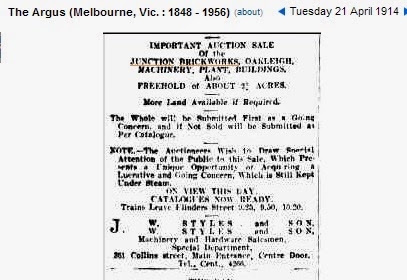Context
Historic context
Victoria has developed exponentially since European settlement. Originally timber huts housed a small but growing population. A legacy of the gold rush of the 1850s was an oversupply of underemployed miners. The extensive basalt plains of Victoria were a fertile ground for stonemasons who built the magnificent cities we see in Victoria today. These masons could not keep up with the demand as working basalt is a slow process. Brick makers then filled this gap and brick works popped up all over the colony as the population grew more affluent and wanted a better standard of housing.
This cultural and industrial heritage has largely been lost. The brick kilns are now gone. But the bricks remain. They are everywhere. Australia is now, as has been for a long time, the world’s largest per capita consumer of bricks. Nobody gives them a second thought. Many new arrivals in post-war Australia worked making bricks. Maybe one of your relatives was such a person. Almost nothing has been done in Victoria by the State Government to record this history, except a half-hearted attempt in the early 1980s by the Victoria State Archaeological Survey to record a few brick that came their way at a few sites. What ever became of them? Although some good came of it because a paper on “The Analysis of Bricks from Archaeological Sites in Australia; IAIN STUART” was produced. See it at http://www.jcis.net.au/data/23-04-Stuart.pdf
Even half the bricks we use today smash like China tea-pots if you drop them from any sort of height. Not like the old Victorian bricks. Oh no, they knew how to build houses in those days.
“Blue Collar”, P16, Danny King
What I want to do here is to show pictures of some of the bricks I have come across in my travels and give a short story about their maker. If you have anything to add, please let me know. PS: I do not collect bricks, only photographs of bricks. If you have some old bricks, let me know and I may come and photograph them and maybe find a story about them.
Saturday, April 5, 2014
Hammill, Avoca
Selkirk, Allendale
Wednesday, April 2, 2014
Junction Brick Company
Trading Name
|
Oakleigh Brick Company
also known as the
"Oakleigh Brick and Tile Company"
and the “Junction
Brick Company”
|
Years of
Operation
|
1909 to 1921
|
Company Number
|
C0000832T
|
Address
|
Ferntree Gully Road to the North, Dandenong Road to the
South and Tanner Street to the East.
|
Council Lot No.
|
|
Coordinates
|
-37.896937,
145.100598
|
Current Use
|
Public Open Space
(Hurst Park)
|
Junction Brick Works Site 1931
Aerial photograph courtesy of the Department of Environment and Primary Industries, Victoria
On the 17th of April 1929 the owners of the disused tile works at the corner of Dandenong and Fern Tree Gully Roads were given 14 days to erect a substantial fence around the clay hole. I don’t think that this referred to the corner site. If you look at the right of the picture, the remains of Scott’s pit can be seen encroaching onto Dandenong Road. There is a reference to this company being started by the Moroney Brothers but there appears to be no evidence of this. The carefully manicured parkland there now shows no sign of its former life.
|









